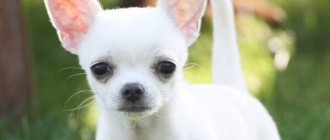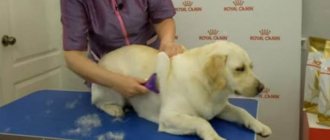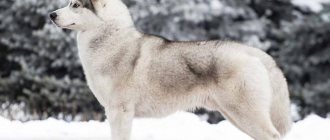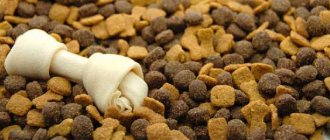Laikas come from Eastern and Western Siberia. This breed was bred in the harsh conditions of the Siberian Arctic seas, where it was used for herding animals and transporting goods over long distances in frozen tundra conditions. As fur traders made their way to Alaska in the early 20th century, they used Siberian huskies on these passages.
This breed was successfully used to transport valuable medicines to Alaska. During Admiral Peary's Antarctic expeditions, these dogs pulled sleds with equipment. During World War II they were involved in rescue operations in Arctic regions.
Purpose of huskies
The amazing hunting instincts of northern dogs are genetically determined. The dog's goal is to track and bark at game. She must indicate the location of the beast, distract her from the hunter.
Dogs have an excellent sense of smell and a loud bark; they can track animals even after 12 hours; they also work in a team, for example, to hunt a bear.
The pet shows its best hunting skills:
- for small game - quickly finds and bites the neck, but does not damage the skin;
- on a squirrel or sable - covers vast territories and informs the hunter with a loud bark;
- on a capercaillie or hazel grouse - it almost sneaks, and when it gets close, it barks, indicating the place of the bird;
- for waterfowl - the dog walks alongside, carefully sniffs the scent of the bird, after shooting, rushes into the water and delivers it to the owner;
- at a bear - first it barks when the predator tries to leave, bites painfully on the legs, showing miracles of resourcefulness and speed of reaction.
Breed Features
Known for their amazing performance and beautiful appearance, affectionate and loyal nature, huskies are a very popular choice, both as a pet and as a helper. They are athletic, smart, resilient and energetic. They love to be in the company of other huskies. They have a double coat and thick fur, perky ears and a unique color.
Breed varieties
The main, most common types of huskies:
- Russian-European Laika;
- West Siberian Laika;
- East Siberian Laika;
- Karelian-Finnish Laika;
- Finnish Spitz;
- Yakut Laika;
- Norwegian gray elk husky;
- Karelian bear husky.
Appearance
Consider the Siberian Laika, a very attractive dog that is known for its resemblance to a wolf. They are medium in size, with males slightly heavier and larger than females.
Height at withers/weight:
- males 53 - 61 cm, 20 - 27 kg;
- females 51 - 56 cm, 16 - 23 kg.
The proportions of their head are harmonious in relation to the rest of the body. Their skull is slightly domed and their muzzle is moderately long and wide, tapering towards the nose (which can be black, brown, or flesh-colored, depending on the dog's coat color).
The eyes are almond-shaped and can be blue or brown. This breed often has a sharp, focused gaze, and is also often mischievous and friendly.
The ears are medium in size and close set, positioned high on the dog's head. They are triangular in shape, slightly wider at the base, and held very straight. Fleshy, well covered with hair and have slightly rounded tips. Laikas have strong jaws with a perfect scissor bite, with the upper teeth neatly overlapping the lower teeth.
The neck is moderately long and powerful, the shoulders are well laid back, the front legs are muscular and straight. Their bodies are strong, have a broad chest with well-arched ribs, and always with well-developed muscles. Powerful hind legs - thanks to the developed upper thighs. Paws with small membranes between the toes, compact, oval-shaped, medium in size, well protected by fur. The tail is well covered with hair and is very reminiscent of a fox's tail.
The Laika has a thick, medium-length coat that lies close to the dog's body, with an undercoat that is thicker and softer than the outer coat.
Character
Laika is delighted to be in the company of people and sincerely enjoys their company. She forms very close social bonds with her owners. Gets along well with children and enjoys playing with them. She is very devoted and submissive to her owners, in extreme situations she is ready to sacrifice her life to save her guardian.
The habits of dogs of this breed are similar to almost all others (yelping, scratching, yawning, barking). If the husky is hungry or sick, it will howl or scream. They boast a very strong hunting instinct, which can become unsafe for small pets, including cats.
The Laika is known to love the sound of its own voice and can be very noisy at times with howling dogs.
They are very hardy, strong, and do not feel the cold thanks to their thick double “fur coat.” They need an abundance of mental stimulation and exercise to become a well-balanced dog.
If you leave your pet alone for any length of time, you will soon notice that the dog is bored and develops some unwanted behavioral problems, namely: excessive howling and the desire for various sabotage. Laika is a harmlessly cunning dog, athletic and flexible, so skillfully leaving the enclosure or any barriers will not be difficult for her. The most reliable and high barriers may also not stop the husky; they are very good at digging under the fence.
Since these dogs have a brilliant mind, this can make the training and training process somewhat difficult. They are a good choice for people who are familiar with this type of dog, but not for the first-time owner.
Caring for your husky
The breeds were bred for the harsh northern climate; heat has a negative impact on the dog’s health.
During shedding, the coat should be combed twice a week with a stiff comb. At other times, the husky itself will monitor it. She is very clean.
Bathe your dog only when necessary. Otherwise, the beautiful “fur coat” will become dull and the natural fat will be washed away. Swim only with air conditioning.
The eyes never become sour; for prevention, it is permissible to wipe with a damp cloth.
Inspect your ears regularly, wipe the ears with a damp swab 2 times a month to prevent wax from accumulating.
Claws. If the dog leads an active life (running or hunting), they will wear off on their own. Otherwise, you will have to prune once every few months.
Inspect the dog's paws, avoid cuts and abrasions. Wipe paws with a damp cloth after going outside.
Outdoor content
For the Laika, the street is her element. Here she will feel confident and comfortable, and will always be cheerful and cheerful. Dogs of these breeds are unpretentious and independent. For a prosperous existence in an open area, you should think about its habitat. This could be a booth or another building.
But in the best case scenario, this is an enclosure for a husky. It is desirable that it be collapsible to make it easier to clean.
The construction process can be divided into 5 stages:
- Determining the dimensions of the future building.
- Selection of floor materials.
- Installation of walls.
- Installation of roof frame and roof covering.
- Door installation.
The enclosure for huskies provides various modifications, shapes and dimensions. In a well-insulated home with a leak-proof roof and a reliable floor, the husky will feel like a real owner.
To summarize, it can be noted that likes maintenance and care will not cause you a lot of trouble and problems. And the time spent on training fully compensates for the pleasure gained from hunting or simply communicating with a pet.
Nutrition
Determine immediately:
Dry food is convenient for trips or long trips with your husky.
Homemade food is healthier for such a dog. For good health, a balanced diet is essential.
Feed puppies 5 times a day, when they turn 0.5 years old - 4 times, and adults - 3 times a day.
Advice! Mixing dry food with homemade food is strictly prohibited!
Be sure to have a clean bowl of water, change the water 2 times a day!
Your pet needs to cook food! Cook porridge with meat broth. The dog must eat a portion; if it does not finish, reduce the amount of food.
After any walk (run), feed after 30 minutes.
Puppies can eat meat only when they are 1 year old. Only periodically can you give raw tripe for vitamins.
The diet includes: beef (no other meat), poultry, cleaned sea fish (no river fish!), dairy products (eggs, cottage cheese, kefir), nutritious porridges (buckwheat, rice, etc.), various vegetables and herbs.
You can give 1 fruit a day, monitor the reaction to avoid allergies.
Important! Do not give: spices, chocolate, soda, potatoes, smoked meats.
Choose the most inquisitive and nimble puppies, this is an indicator of excellent health. If you feed properly and lead an active life, you will gain a best friend, helper and protector.
We offer a photo gallery of all types of huskies.
Education and training
As mentioned earlier, this breed has a fairly high intellectual potential, which makes training a little labor-intensive and lengthy, although many of the dogs pick up everything on the fly. The result of a correctly followed process will be a true friend and helper.
Their training and education should begin from the first day the puppy enters its future home. Many basics can be taught to a puppy in a game (teach him a nickname, introduce him to fears, teach him to search, teach him to fetch objects). Over time, move on to mastering the simplest commands, introduce him to a leash and collar, and get him interested in water. Gradually the difficulty of training will increase, but believe me, this is life for the husky!
Photo of Laika dog
\
Origin, history, creation
In ancient times, huskies were the name given to ordinary yard dogs living in almost every yard. They were called “yard dogs”, “northern pointy-eared dogs”, “pointy-eared dogs”. The Laika dog breed received its official name relatively recently.
The purpose of the breed has long been hunting. But if in the European part of Russia hunting was, for the most part, the prerogative of aristocrats who used hounds for this purpose, then for the peoples of the North and Siberia, fur fishing remained one of the main types of export trade. That is why increased demands were placed on hunting dogs, which the Laika met perfectly.
In the harsh conditions of the northern climate, dogs developed endurance, strength and other character traits, thanks to which they could bring real benefits to humans.
Interesting! Individuals that were considered useless and weak were not used by hunters for hunting and were destroyed, since it was not economically profitable to keep them. As they explored the North, newcomers brought dogs with them, and when mixed with them, the “witties” lost the purity of their blood, and with it their unique hunting qualities. Residents of the North also tried to eliminate the “half-breeds.” Now it seems cruel, but it was this method of breeding dogs that contributed to the emergence of a breed that is today considered one of the best in the world in terms of hunting characteristics.
Experts distinguish two periods of origin of the Laika breed. The first is the result of a hundred years of selection by hunters of the strongest dogs that hunt large animals, the second is the standardization of the breed, which began in the 20th century.
The first research and work on factory breeding with Ostroushkek began in the century before last. Active work began to promote this breed: publication of scientific research articles, publication of a separate book “The Laika and Hunting with It.” The first nurseries were formed, which contained the best representatives of this breed.
The Laika was approved as an official breed in 1925, and a few years later at the First All-Union Exhibition of Hunting Dogs, Laikas were very widely represented, which proved their enormous popularity among hunters.
Initially, huskies were classified into certain species according to the names of the peoples who bred them. Several ecotypes are known, each of which has certain features of appearance. At the end of the 30s of the last century, when cynologists identified Finno-Karelian, Karelian, Mansi, Khantei and Zyryan Laikas.
During the Great Patriotic War, the Laika dog was on the verge of extinction, so breeding work was interrupted, and the number of hunting dogs was significantly reduced. But they continued to be assistants to people: they were used as demolitions, mine-search dogs, messengers, ambulance dogs, and used to transport cargo and ammunition. Due to the fact that the country needed furs, the organization of nurseries was resumed.
Factory breeding required the creation of a new breed classification and a revision of existing breed standards. At the end of the 40s, cynologists decided to approve four temporary standards: Russian-European, Karelian-Finnish, West Siberian, East Siberian.
In the middle of the last century, breeding work was actively carried out, nurseries were created to improve the breed, but with the collapse of the USSR, the Laika dog began to degenerate. This was due to the closure of the kennel, when the best representatives of this breed ended up on the street, where they mixed with yard dogs.
Today the breed has become popular again. The following types of huskies are considered the most common:
- West Siberian;
- East Siberian;
- Russian-European;
- Norwegian;
- Swedish;
- Karelian-Finnish;
- Finnish.
In Russia and the CIS, the first three species are most often found.
Interesting! Some experts classify Siberian Huskies as the breed we are considering. The Laika Husky is a dog that was bred in Siberia by the Chukchi. It was used as a means of transportation - it, along with its relatives, was harnessed to a harness.
Characteristics, description, character
For the Laika dog, a description of the breed was compiled back in 1939. But the standard was temporary; a permanent standard was approved in 1952.
The Laika breed has a freedom-loving and independent character, but at the same time very loyal.
When hunting, they take on a leading role, clearly understanding why this or that action is needed. They give the owner the opportunity to make a well-aimed shot, diverting attention to himself. The husky does not hunt for itself - it is simply not interesting to it, it works for humans, and in the event of an unforeseen dangerous situation, it will sacrifice itself without hesitation.
Puppies
Choosing a pet is not an easy task, since the husky is a whole group of breeds with significant differences. First you need to decide for what purpose you are getting a dog. If an attractive exterior is a priority for the owner, then you should choose a puppy based on its external characteristics.
If a husky puppy is purchased for hunting, then appearance alone is not enough. Without skills in the basics of dog breeding and knowledge of the peculiarities of keeping the breed, it will not be easy to manage huskies, since they are distinguished by their freedom-loving character and independence. This breed is absolutely not suitable for homebodies, opponents of hunting and lovers of silence.
There are often cases when a person who does not have training skills acquires an adult dog. This is not recommended. Laikas are monogamous people who remain devoted to their first owner until the end of their lives; they will not be able to accept the new owner and will not obey him.
The best option for choosing a puppy is to contact practicing hunters or a well-known nursery, where the future owner is required to show the documents for the puppy and the working diplomas of the parents.
The decisive factor in the choice is the character of the student. A Laika puppy should be cheerful, playful and healthy. It is better for a hunter to choose a medium-sized puppy. You can take your pet home at the age of one and a half months.
Exhibition career
If you plan to get offspring from your husky , you will have to visit at least one certified exhibition and go through the grading - a comprehensive assessment of the animal’s compliance with the breed standard. Everything will be taken into account:
- exterior;
- origin;
- quality of offspring (if you already have one);
- work qualities and character.
Preparing for an exhibition is not the easiest task. You will need:
- take care of your pet’s excellent appearance;
- teach him to stand upright, show his teeth, and react with dignity to the presence of strangers.
You can't be born a champion. Even puppies rated as potential show and breeding class may not live up to expectations. Laika can only be raised , and raised with an eye toward future competitions.
Hunting training
It is worth noting that not every husky puppy can be taught hunting skills. In order to determine whether your dog is suitable as a cop, you need to observe its habits and disposition, especially in relation to fresh tracks of other animals. If the dog is indifferent to them, then he will not become a hunter. However, if your four-legged friend is constantly sniffing at them, it would be advisable to conduct several training sessions to teach hunting wisdom.
The optimal age for becoming familiar with the character and disposition of an animal is 10 months. At this time, you can go into the forest with your dog and see what object he chooses for hunting. It is desirable that the vegetation in this forest be relatively low.
The training process involves several tricks, as a result of which the animal will learn to be an obedient companion and an intelligent watchman. First, you will need to accustom your pet to the forest in order to develop the hunter's instinct in him. Don't spare your personal time and let the puppy run around the forest to his heart's content. He must sniff and examine all the places that interest him. As a result of various canine techniques, you can teach a dog:
- detain large prey in one place;
- distract the attention of predators from the owner;
- to attack the trail of this or that prey;
- scare wild birds by raising them on the wing.
As a rule, the husky quickly gets used to hunting certain game. It will not be difficult for such a dog to catch a hare, squirrel or marten. Don't forget to praise your dog for any success he achieves. It is necessary to make it clear to the cop that her actions are correct. Only in this case will you be able to raise a faithful assistant and a good hunter.
We hope our article helped you better understand what to feed your husky puppy. Remember that the diet should consist only of natural products, and not prepared foods. Also, you should not overfeed a young dog if you want to raise him to be a hunting assistant and not a couch potato.
Diseases
Laikas are distinguished by good health. This is due to the careful selection, because only physically strong dogs can benefit the hunter.
Among the most common diseases in huskies are:
- diabetes;
- renal failure;
- deafness
- glaucoma
- retinal atrophy;
- bloating;
- hip dysplasia.
Prices
The price for the Laika breed is low. Even a purebred husky can be purchased at a price lower than that of representatives of other hunting breeds, however, you should only purchase a puppy from trusted breeders.
The price for a baby without a metric can range from 5,000 to 7,000 rubles. This is an excellent option for people who do not plan to breed the breed or exhibit them at Russian or international exhibitions.
A top-class purebred husky costs from 10,000 rubles and above. However, such a high price is determined not only by the exterior, which is as close as possible to the ideal and the purity of the pedigree, but also by the merits of the manufacturer and the fame of the nursery.
So how much does a like cost? The cost of an adult hunting husky depends on the size of the animal it can hunt. Compare:
- “squirrel breeds” from trusted breeders cost 5000-7000,
- “sablehouses” – 7000-9000,
- large game hunters – from 10,000 rubles.
Kennels sell vaccinated and healthy puppies with good pedigree, from working champion parents. However, for many future owners, purebred is not important, so they turn to private sellers, whose puppies are much cheaper. For this reason, there are not many nurseries specializing in breeding huskies.
West Siberian
This breed is the most numerous, in terms of the number of heads, and the most common among hunters. It is distinguished by its predatory appearance; it is more like a wolf in color and temperament than others. Not large in size - 52-60 cm at the withers, with a weight of 16-22 kg . Externally a strong animal, elongated format. It is considered a universal hunting dog.
Country of origin: USSR (Russia). The breed received recognition in 1980 and is officially registered by the International Canine Organization.
In proportions and appearance it is not much different from the East Siberian. A special feature can be considered deep-set, sharply slanted eyes and a predatory gaze. Preferred colors : white, piebald, brown, gray, red.
The breed does not cause any difficulties in caring for. West Siberian huskies are unpretentious. They can go for a long time without water and food, work hard, and hunt. Such dogs need space; living in an apartment will negatively affect their well-being. In order for a pet to live on the street, it needs to be equipped with an enclosure or a booth with a soft chain. It is important to regularly go hunting with your animal or just for walks in the forest.
Read a detailed article about the breed: “The West Siberian Laika is an excellent hunter and a cheerful companion.”
A puppy without a pedigree can be purchased for 3,000-5,000 rubles , a pet-class or breed-class for 15,000-20,000 rubles , a show class dog for 25,000 rubles .
Plate holder
It is recommended to purchase a special stand for the bowl from which your four-legged friend will eat from your nearest pet store. An alternative to factory models is an ordinary children's stool, which is just the right height for a two-month-old puppy. However, do not forget to make a small depression in the middle of such a device so that the animal does not accidentally knock over the bowl during the meal.
The bowl should be placed at the level of the dog's chest. A different position may lead to deterioration of the young hunter’s posture. If necessary, file the legs of the chair with a hacksaw, but remember that the stand should not wobble or fall. When the puppy grows up a little, you can place a wooden plank under the high chair.











